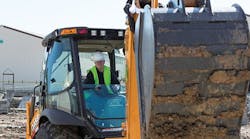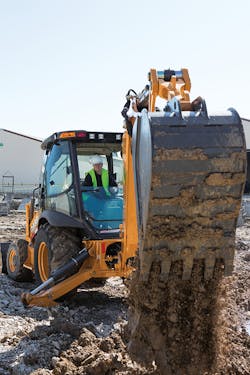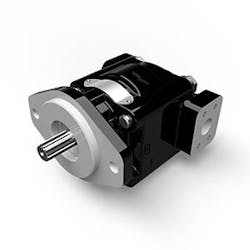Case Construction Equipment, Racine, Wis., has added a Tier-4 Final version to its popular 580N series of loader backhoes. The 580N EP is a lower-horsepower version of the 580N, but maintains the same lift capacity and breakout force with greater fuel efficiency and a maintenance-free Tier-4 Final power package. Ease of operation, versatility, and low maintenance requirements make it especially well suited for entry-level contractors and the rental market.
The 580N EP is powered by a 74 hp @ 2,200 rpm diesel engine driving a mechanical power train, and the machine’s hydraulics. With a backhoe bucket breakout force and lift capacity of 11,517 lb and 2,858 lb, respectively, the 580N EP provides ample power and performance while keeping fuel, maintenance, and total cost of ownership low. Many of these benefits are attributed to the machine’s hydraulics.
Anatomy of the Hydraulics
The 580N EP is driven by a Parker Hannifin P330 single-section gear pump, which delivers 28.5 gpm of flow at 3,350 psi whether in loader or backhoe function. Hydraulic fluid is filtered to 7 µm through a full-flow, spin-on, return filter.
Depending on requirements, the loader control uses a two- or three-spool open center monoblock valve. Either version has a single-lever manual control for lift and tilt functions. The three-spool valve uses a proportional electrohydraulic control for the auxiliary function. The lift lever has a positive hold float position and a return-to-dig feature to improve productivity.
The backhoe function can use either manual or pilot control. The manual version uses a six- or seven-spool monoblock open-center control valve with an open-center parallel circuit for all functions. The pilot version uses a six-, seven-, or eight-spool sectional closed-center valve with circuits in parallel with a post-compensated, flow-sharing feature for simultaneous operation of all circuits.
The 580N EP has an auxiliary hydraulic system with full flow available and is actuated through a proportional thumb switch with a detent on the loader-control handle. The auxiliary hydraulics includes a unidirectional system as standard, with bidirectional available. Its hydraulic control valve is equipped with an adjustable load-sensing relief valve to control attachment pressure and a six-position flow control selector with six detented, distinct flow settings. Actuation is accomplished using a cab floor pedal for machines fitted with manual backhoe controls or a left-hand joystick for those with pilot controls.
Depending on equipment, the hydraulic system holds up to 28 gal of oil, with roughly half of that in the reservoir. The loader’s two lift cylinders have a bore or 3.25 in, stroke of 30.2 in., and a piston rod diameter of 1.75 in. Its two dump cylinders have a bore and stroke of 3.00 in., 9.18 in., respectively, and also a 1.75-in. rod.
The backhoe has a 4.50-in. bore 38.25-in. stroke boom cylinder with a 2.25-in. diameter piston rod. Its dipperstick (elbow joint) cylinder is has a 4.25-in. bore, 24.74-in. stroke, and also a 2.25-in. rod. The bucket cylinder has a 3.25-in bore, 35.35-in. stroke, and, again, a 2.25-in. rod. The backhoe’s two swing cylinders are 3.75-in. bore, 11.50-in. stroke, and 2.00-in. rod.
Benefits of Hydraulics
The 580N EP offers several benefits over the competition and its previous counterparts. It comes standard with ProControl, a swing-dampening system that eliminates rebound on the backhoe, providing faster cycle times, less wear on components, greater operator precision, and less operator fatigue.
Power Lift allows contractors to increase hydraulic capacities of the boom and bucket forces. This provides as much as 8% lifting more lifting power from a smaller, more fuel-efficient machine. It also reduces engine speed for greater control of the load being lifted.
Another production-boosting feature is the industry’s only fully integrated hydraulic quick coupler. This feature proves valuable for users who regularly change buckets or attachments because they save time and effort by being able to change implements without leaving the cab.
The 580N EP offers added convenience because operators can quickly and easily attach any of several external tools to its auxiliary hydraulic system. This eliminates the need for transporting air compressors, generators, and other heavy equipment to a job site.
A popular option is Case’s Extendahoe feature, which adds even more versatility to the 580N EP. Extendahoe uses 3.00-in. bore cylinder in the dipperstick to extend the length of the dipperstick more than 40 in. In normal operation, the 580N EP can work in tight spaces. But when additional reach is needed, the Extendahoe cylinder can be activated for up to 42.05 in. of additional reach. Doing so allows more work to get done without moving the machine. It also provides access to sites where the backhoe can’t get as close to the work area due to regulations or obstacles.
For more on the 580N EP and the entire line of Case backhoe loaders, visit CaseCE.com.




